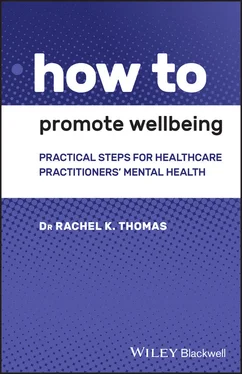The idea that clinicians suffer from ‘injury’, such as burnout, due to an over‐stretched healthcare system is increasingly becoming apparent. The COVID‐19 crisis has highlighted how our healthcare systems need to protect not only the patients, but also the clinicians and other healthcare practitioners working within the system.
While positive steps towards improving mental health and wellbeing for the general population are being taken, such as increased conversation and decreased stigma around mental health and wellbeing, this progress has arguably not translated to clinicians. Research reveals that mental health conditions are increasing in this group, and that these conditions may be exacerbated by perceived reluctance or delay in seeking additional help and support. Conditions such as burnout and injury may not be due to failures in the individual clinician, but rather more due to factors such as excessive workloads, workplace culture, or overall work environment.
The importance of the wellbeing of clinicians is being increasingly recognised. However, although well‐intentioned advice to support us may be given, this may seem impractical at the times when it is needed most. Some of this advice may seem tone‐deaf to the real‐world practicalities of when we are ‘on the job’. This is not to say that the role of people in different fields in helping to protect and preserve our mental health and wellbeing is unhelpful. Quite the contrary. We need people who have a more objective view of what a work–life balance is, to help many of us in healthcare roles who have long‐forgotten the concept, albeit through no fault of our own. This slow erosion of our work–life balance often starts early in our training. The sheer quantity of knowledge we are required to digest and retain, the stress of exams, and the very nature of the areas we are training to become proficient in, can leave us with a different perspective of what work is, what life is, and how, exactly are we to balance the two.
A hospital I once worked in had a brightly coloured poster informing us of ways to decrease our stress. The poster had 10 small sketches, with information added in artistic calligraphy. Each suggestion was sensible, and indeed even likely to be very useful in many occupations. However, healthcare often isn’t just any regular profession. At times, suggestions to leave work on time, and to make sure we take our lunch breaks, are practically impossible. If a hand‐over is needed, we cannot leave until this is done, no matter whose birthday dinner we are missing – even if it is our own.
It is recognised that, as clinicians, we have conflicting pressures at times. Historically, delivering high quality patient care along with maintaining our own personal health and wellbeing were often perceived as being at odds with each other – that pausing for ourselves meant neglecting patients. However, it is time for us to challenge these historical views in light of evidence showing we need to, as the airline safety videos so succintly phrase it, ‘put on our own oxygen mask first’, in order to continue to deliver and perform optimally throughout our career. This has never been more acutely highlighted than during the COVID‐19 pandemic, where, due to forces beyond our control, our inability to always put on our own mask first – literally – led to sacrifices not only of wellbeing, but of life.
While highlighting many of the benefits, and our sense of pride, in the healthcare system’s responsiveness as a whole, the COVID‐19 pandemic has also highlighted areas for improvement, and stimulated discussion on how this could be achieved.
Research increasingly supports evidence of the significant links between mental and physical health. Evidence suggests that patients with mental health issues are more likely to have physical health issues, leading to poorer health outcomes. For instance, it has been shown that patients with cardiovascular disease are also more likely to have depression, when compared to the rest of the general population. 1Conversely, there is also evidence that people with depression are more likely to develop cardiovascular disease, when compared to those who are not depressed. 1So it is important to take a patient’s mental health into consideration when evaluating their physical health, as this may lead to a better outcome overall. Additionally, in turn, better outcomes for the patient may link to better outcomes for us, their healthcare practitioners.
The information in this book is relevant to clinicians and other healthcare practitioners – doctors, nurses, dentists, physiotherapists, counsellors, therapists, and other associated team members. Reading it may count towards our continuing professional development points. Combining the suggested strategies with elements of reflection will assist us in promoting and strengthening our own mental health and wellbeing – in turn, in helping us to deliver optimal outcomes for our patients.
During the COVID‐19 pandemic, we worked in a healthcare system that responded flexibly to the demands placed upon it. We were called to work in different areas and in different ways, while the infrastructure around us also changed. New hospitals were built and staffed within days in the UK and USA, highlighting the flexibility for a rapid response within the system. However, it also highlighted a period of potential need for increased support for healthcare practitioners. Embracing this newly‐found flexibility, we can now consider creating a more balanced set‐point for how our healthcare system works, with an increased focus on the mental health and wellbeing of the clinicians who work within it.
As clinicians, we are trained to focus on improving the health of our patients. However, this focus, due to numerous reasons, can become so singular that we neglect to look after ourselves.
Healthcare is an extremely rewarding profession. Its capacity to be varied, intense, and emotional offers challenge and high personal satisfaction. The opportunity to help a fellow human at their most vulnerable is a great honour.
However, being a clinician also comes with stress and pressure. The pressures of such a job – and really, for many of us, it becomes more than just a ‘job’ – come from endless sources. Some pressures are due to systemic, institutional, and organisational aspects, baked into the hospital infrastructure, such as rota hours. Some are cultural, such as the stigma still remaining of mentioning our own mental health issues, where we are part of a profession many people assume is immune from such problems. Education and awareness may be sources of pressure, when appropriate resources are not clear, or even available. In times of crisis, the stress may be operational, such as an increased stretching of teams, inadequate support, or inadequate supplies of personal protective equipment (PPE). Hence, while, unfortunately, many areas may cause stress and pressure, these fortunately also provide many opportunities to improve the situation.
It is not surprising, then, that the accumulation of these factors, compounded by our inherent obligation of responsibility for other people’s lives on a daily basis, leads to a profession in which there are high rates of burnout and mental distress.
The impact of burnout and mental distress can lead to immeasurable cost, not only to our own health but, ironically, also to the health of those we are aiming to help. In many studies, clinicians’ decreased wellbeing is associated with poorer patient outcomes. Poorer patient outcomes are associated with decreased job enjoyment – which ultimately may lead to more clinicians leaving due to burnout. This leads to fewer clinicians, and it is not hard to see that this can then lead to a compounding effect with even greater stretching of resources and fewer clinicians available. So, in being too devoted to our profession, we may instead actually be undercutting our main priority – our commitment to helping our patients.
Читать дальше












